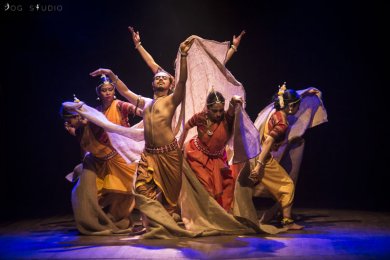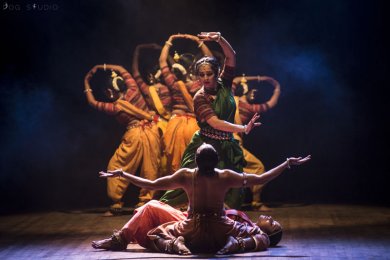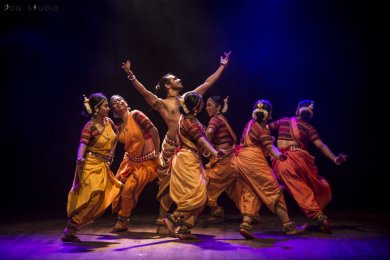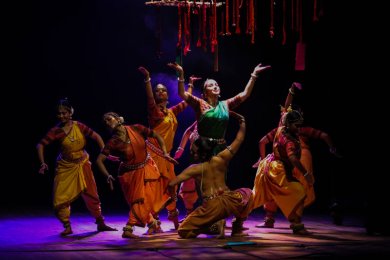
|   |

|   |
 e-mail: ukb7@rediffmail.com Folk Art embodying eternal spirit Photos: Dog Studio April 14, 2018 Mrudanga (literally meaning "clay limb") in Odisha - not to be confused with mridangam of Carnatic performing arts - is a terracotta two-sided drum familiar all over northern and eastern India. An essential accompaniment for devotional music and dance, it is also known as khol in West Bengal, Assam and Manipur. Prevalent from antiquity, it has specially haloed association with Shri Chaitanya in Bengal and Saint Sankaradeva of Assam since the bhakti movement of the 16-17th century. 

Murchhana was presented on April 6 by Odissi dancer Sharmila Biswas with her well trained co-dancers in a very well attended ticketed show in Kolkata. The fascinating idea came to her - in episodic form - narrated by the mrudanga players when she was conducting research on the rural percussion instruments of Odisha. During the annual mrudanga making season, the mythic tales were repeatedly told to her through verses and songs (carefully culled and reworked) as part of mrudanga purification ritual and carried forward as an oral tradition. Said Sharmila, "The folk artists believe that whenever a man plays the mrudanga with his whole being immersed in his art, murchhana, the spirit, enters and possesses the mrudanga, stirring the person from within. It transforms him, and his art elevates to a spiritual level. It brings supreme bliss." It is interesting here to observe that murchhana is very much part of the ancient marga tradition - prevalent possibly even before Bharata compiled his Natya Shastra at the turn of the Christian millennium. It constituted the gram (scale) of music with seven swaras (notes) and constituted their srutis (microtonal intervals), ultimately helping to define the ascent and descent of ragas. In an amazing synthesis of the marga and the desi traditions, the former informed the latter and seemingly handed down the muse's spirit orally from generation to generation. In a beautifully designed proscenium - with the multi-canopied akhada (practice space) decorated with filigreed minutia and an elaborate raas mandala erected at the backstage, and all most exquisitely lit - the performance drew inspiration from the popular folk myths, extending and re-imagining them to explore the concept of murchhana. In a vachik abhinaya, an on-stage English narrative was used by the dancers themselves throughout the performance, a major innovation for a classical dance performance, but it surprisingly jelled well with the flow. In the opening myth, the supreme god Brahma helped create the first language from the child's prattle and Rambha, the dancing apsara, was seen interacting with both earth and ocean to mould the constituents of shabda, referring to the various sounds heard inside and outside. While nada was the primordial basis of all these sounds, the point where they culminated - when a singer held a note in perfect pitch and completed it - faded smoothly and became one with the srutis. This was indeed embodiment of murchhana and was perhaps the initiating articulation of nada. 

The second myth was about the music arising from passion and power, and the quest for an everlasting youth. The dancers visualized Samudra Manthana, churning of the primal ocean and Vishnu's taking the guise of Mohini that mesmerized the gods and the demons alike. Mohini led the yearning for harmony in the cosmos and the mrudanga found its shape and contour in the dreams of the dancers. In the final myth, mrudanga received its structure in the hands of Krishna, when he instilled the body of Tungavidya (supreme knowledge) into its systematic playing and the scene shifted to a charming raas lila of the cowherd god with the congregation of milk maidens. This was very well enacted covering the entire proscenium. "The story of Murchhana has a mystical quality, and many subtleties. It has a rustic spirituality. It weaves in a beautiful story telling technique through which the narrator effortlessly floats between the real and the make belief, holding the audience spellbound. It is unique in the way in which traditional artistes capture the infinite and inexplicable through very simple gestures and words. Our choreography seeks to communicate these myriad qualities," concluded Sharmila, with the show greeted with an enthusiastic ovation at the end.  Dr. Utpal K Banerjee is a scholar-commentator on performing arts over last four decades. He has authored 23 books on Indian art and culture, and 10 on Tagore studies. He served IGNCA as National Project Director, was a Tagore Research Scholar and is recipient of Padma Shri. Post your comments Please provide your name and email id when you use the Anonymous profile in the blog to post a comment. All appropriate comments posted with name & email id in the blog will also be featured in the site. |